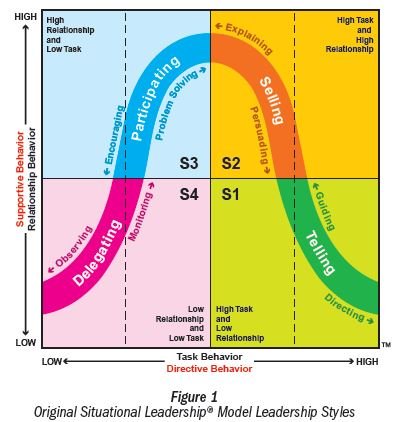Part 6: Situational Leadership
Why we should strive to become both a situational leader and a conscious follower?

Leaders need to adapt their style to fit the performance readiness of their followers. Readiness not only varies by person, it also varies by task. Followers have different levels of motivation and ability for different tasks.
An outstanding salesman might have a high readiness level for the task of calling on customers, but a low readiness level for completing sales reports. The most effective leaders can vary their leadership style to fit the needs of the situation.
Leaders should:
- Keep track of the shifting levels of readiness among their followers
- Stay highly attuned to each situation
- Acknowledge that situations change constantly,
- Fine tune their leadership style to fit the followers readiness
4 distinct style of leadership:
1. Directing:
- Requiring specific guidance to complete the task
- Primarily one way conversation, with little input from the employee
- "Here’s what I like you to do, step by step. And here's when I need it done"
2. Coaching:
- Need more than average guidance to complete the task, but with above average two way dialogue
- "Here’s what Id like you to do, what do you think?"
3. Supporting:
- For employees with the skills to complete the task but may lack the confidence to do it on their own.
- "How can I help you on this one?"
4. Delegating:
- For people who score highly on motivation, ability, and confidence.
- They know what to do, and how to do it, and can do it on their own
- "If I can help, just ask. If not, you’re on your own".
One style is not better than another. Each is appropriate to the situation. Effective leaders know this intuitively. Measure your need, choose your style. Inside each of us are two separate persona:
- A leader/planner/manager; who plans to change his or her way
- A follower/doer/employee ; who must execute the plan
We think they are the same because we unwittingly function as one or the other throughout the day. They are both part of who we are, but we are wrong. In fact, we start each day as a bifurcated individual, one part leader, the other part follower and as the day progresses, the two grow further apart.
We tend to ignore the possibility that the worker in you will be upset by a customer or colleague, or called away to deal with an emergency, or fall behind because a meeting ran overtime. So you still have to consider that as the day goes on and your energy level diminishes, your motivation and self-discipline will flag.
What if the planner in each of us, like an effective leader with his or her subordinates, could size up the situation at any point during the day and adopt the appropriate management style for the doer in us?
We measure the need, choose the style.
We often don’t write the goal down, slot it for a specific time, or ask our assistant to remind us to do it. The planner in us is delegating the job to the doer in us, and assuming it will get done. Other task and situation, however demand a heavier guiding hand. In this situational approach, how we manage others is how we should manage ourselves.
In order to change unproductive behavior as a leader of others, we must first had to change the behavior between the leader and the follower inside.
Everyone has a plan until they get punched in the face, as we wander through life. What punches us in the face repeatedly is often our environment.
